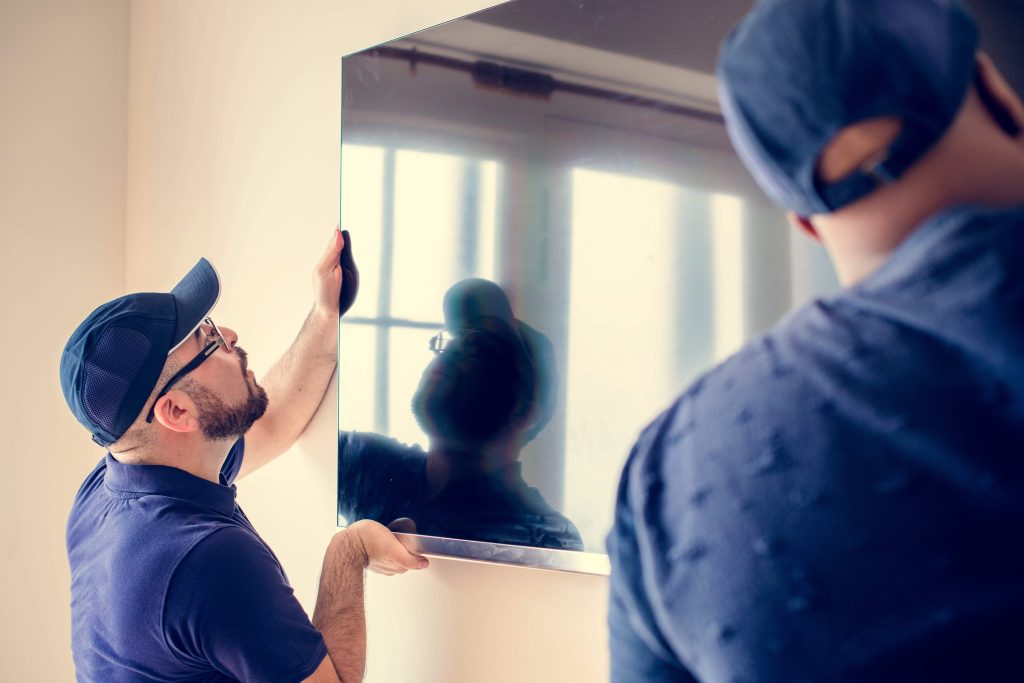
Elevating your entertainment experience often means mounting your flat-screen TV on drywall. While this decision merges aesthetics with function, the emphasis on safety remains crucial. Drywall, by itself, might not bear the hefty weight of today’s screens. The studs, hidden behind, offer the real anchorage. Armed with a trusty stud finder and robust mounting gear, and maybe a dash of expert advice, your TV setup can be as steadfast as it is sleek.
The Journey of Drywall from Historic Beginnings to Today’s Homes
Born in the early 20th century, drywall or otherwise called a gypsum board, emerged as a response to tedious lath and plaster constructions. Essentially, it’s gypsum sandwiched between paper sheets, transforming interiors rapidly and efficiently. Various drywall types have surfaced over time: whiteboard, water-resistant green board, veneer plaster-friendly blue board, and specialized ones like fire-resistant Type X or soundproof variants. Among these, the 1/2 inch thickness stands out in today’s homes, lauded for its adaptability. Through its evolution, drywall’s core principle persists: a swifter, sturdy substitute for age-old wall methods.
The Best Way to Mount Your Flat-Screen TV on Drywall
In the world of DIY, not all advice is beneficial, especially about mounting a flat-screen TV. Some tutorials, like a particular YouTube video, suggest mounting on drywall without using studs—a risky approach. Drywall might not have the strength to support both a TV and a wall bracket alone, especially if it is a large TV on a full motion or mantel bracket. Using at least one stud is essential for stability, but using two is ideal. It’s always best to prioritize the safety of your electronics and your home’s aesthetics. With this in mind, aim for both a stylish and safe living room setup.
Hire Professionals For a Safe and Seamless TV Mounting Experience
Taking on the challenge of mounting your TV can be a mix of excitement and apprehension. The beauty of a perfectly hung flat-screen is undeniable, but the risks of mishandling—like inadvertently puncturing a hidden pipe or grazing an unseen wire—loom large. If the uncertainty of such a DIY venture feels overwhelming, or if the toolkit for the task seems like a one-time use investment, it might be wise to entrust this delicate operation to skilled professionals. Professionals can mount TVs safely and smoothly.They not only bring the right tools but also the expertise to ensure your TV becomes a centerpiece, not a concern.
Also Read : Top 10 Stylish DIY Consoles
Decoding Drywall Dilemmas: Your TV Mounting FAQs Answered
The journey to mount a flat-screen TV often leaves homeowners with a flurry of questions. As they sift through myriad tutorials and advice, uncertainty looms. What happens if you hang a TV without studs? Without studs, there’s a high risk of the TV falling due to inadequate support.
Is it safe to mount TV on drywall? It’s safe if you anchor the mount to studs behind the drywall.
Can I hang a TV with drywall anchors? While possible for lighter TVs, it’s generally safer to rely on studs.
How much weight can a no stud TV mount hold? It largely depends on the anchor type and quality, but typically, it’s less than what studs can support.
Will drywall anchors hold a 65 inch TV? Not recommended; such a size typically requires the strength of studs.
Is a 65 inch TV too heavy to mount? Not at all, as long as it’s anchored to studs.
How much weight can a drywall anchor hold? It varies by type, but some can support up to 50 pounds; always check the anchor’s weight rating.
Tackling misconceptions head-on ensures not just a smoother installation but also the longevity of your TV and the integrity of your walls. Whether you’re a DIY enthusiast or someone seeking knowledge before diving in, this FAQ section serves as a compass, guiding you away from potential pitfalls and towards a seamless TV mounting experience.
Prioritizing Peace of Mind Over Risk
A restful night’s sleep should be devoid of anxieties, especially over a high-value investment like a $1200 TV potentially crashing down. While snap toggles boast impressive weight-bearing capacity, as demonstrated in numerous online videos, these demonstrations typically focus on immediate load tests. However, what’s often not showcased is the durability of these snap toggles under prolonged weight stress. In essence, the adage “better safe than sorry” rings particularly true in this scenario. It’s essential to consider both immediate and long-term strain when mounting valuable electronics.
Uncovering Hidden Hazards in Walls
Navigating the challenges of home improvement, especially during endeavors like mounting a TV, you’re diving into a maze of hidden utilities—water, gas, and electrical conduits weaving through your walls. Surprisingly, rather than locating these utilities directly, your mission often becomes pinpointing the spaces between them. These spaces might not always be where logic suggests.
Here’s a distilled guide to steer you through the unseen:
Partition walls, separating rooms like bedrooms, aren’t typically the residence of water or gas pipes. Yet, they might house electrical lines, making cautious navigation essential.
Power lines often leave clues. Electrical outlets hint at their paths. Although skilled electricians tend to route lines in neat horizontal or vertical trajectories, sometimes these lines take the most direct route—even diagonally.
For those seeking a foolproof method, consider investing in a cable detector, available at most hardware stores. These devices detect metal and electrical presences by simply gliding them along your walls. However, remember that the detector’s efficacy might vary based on its technology, wall thickness, and user proficiency. Always be attentive and prioritize safety when diving into such tasks.
Essential Tools for Securely Mounting Your TV on Drywall
Venturing into a DIY TV installation on drywall? A smart decision requires the right tools. Before you begin, ensure you have this essential toolkit on hand to make the process seamless and safe. With the proper equipment, you’ll not only achieve a professional look but also ensure that your flat-screen remains securely mounted for years to come.
1 Stud Finder: Essential for locating the wooden or metal studs behind the drywall to ensure a secure mount. Remember: you get what you paid for. Cheapest stud finders may not be helpful in some situations.
2 Level: To make sure your TV hangs straight.
3 Tape Measure: For accurate placement and height determination.
4 Pencil or Marker: To mark drill points or stud locations.
5 Drill: To create pilot holes for the mounting screws.
6 Drill Bits: Typically, you’ll need various sizes, and possibly a metal bit if you encounter metal studs.
7 Screwdrivers: Both flathead and Phillips, depending on the screws provided with your mount.
8 TV Wall Mount Bracket: Make sure it’s appropriate for the size and weight of your TV.
9 Drywall Anchors: If you’re placing any part of the mount where there isn’t a stud, use high-quality drywall anchors designed for heavy loads.
10 Socket Wrench: Some mounting kits come with bolts that require a socket wrench for tightening.
11 Cable Ties or Clips: For cable management, ensuring power cables and HDMI cords are neat and tidy.
12 Safety Glasses: Protection for your eyes while drilling.
Lastly, don’t forget to have your TV’s manual handy, as well as the mounting kit’s instructions.
In total, if you’re starting from scratch and buying everything new, you might spend anywhere from $100 to $600 or more. If you already own some general tools like a drill or a tape measure, the cost will obviously be lower. Also, remember that prices can change over time and might be different in your area or based on where you shop. Always research current prices and reviews before making purchases.
Conclusion:
Mounting a TV seamlessly and safely onto your wall is an investment not just in aesthetics but also in peace of mind. The foundation, the studs behind the drywall, holds the key to longevity and safety. Why take a risk when you can anchor into certainty? Make the right choice: always mount your TV into studs for a viewing experience that stands the test of time.



